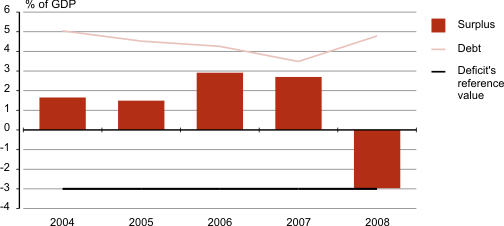General Government's consolidated budget stayed in deficit
In 2008, the total expenditures of the general government sector budget exceeded the revenues by 7.4 billion kroons. The central government sector deficit was 2.4% of GDP, and the consolidated budgets of the local governments sector that had reached surplus for a moment in 2006, but fallen back in deficit again in 2007, had the deficit of 0.8% of GDP. Only the social security funds sector maintained a positive budget position — the revenues exceeded the expenditures by 0.5 billion kroons.
The general government gross debt level, having been in a continuous declining trend since 2002, underwent a steep increase in 2008 compared to recent years, amounting to 12 billion kroons. Last year, the central government’s debt level increased by 1.3 billion kroons compared to 2007, but the borrowing of the local governments sector increased almost twice more than that — by 2.2 billion kroons. In 2008 like a year before, the local governments’ total borrowing accounted for 68% of the general government’s gross debt.
General Government’s consolidated surplus or deficit and debt level, 2004–2008

Statistics Estonia would like to point out that the today released data for 2008 on the general government debt and budget’s deficit as well as the data for the general government debt and budget’s deficit as a percentage of GDP are preliminary. Revised and based on the entirely accrual accounting methods data for 2008 will be published by Statistics Estonia on 30 September. The incorporated change in the accounting method is based on the rules of the European System of Accounts (ESA95) and has been agreed with Eurostat.
Statistics Estonia will also publish the revised GDP aggregates for 2008 on 8 September. This year, Statistics Estonia will conduct, in addition to the regular revision of the national accounts data, the revision of the calculations of actual and imputed rents.
During 4–5 June, Statistics Estonia will be visited by Eurostat’s Mission on Excessive Deficit Procedure whose task is to assess the methodological conformity of the Member States’ accountancy. Circumstances of the change to the accrual accounting method will be one of the matters under discussion. The Mission visits Member States regularly in every one and a half years; the last visit to Estonia was in 2007.